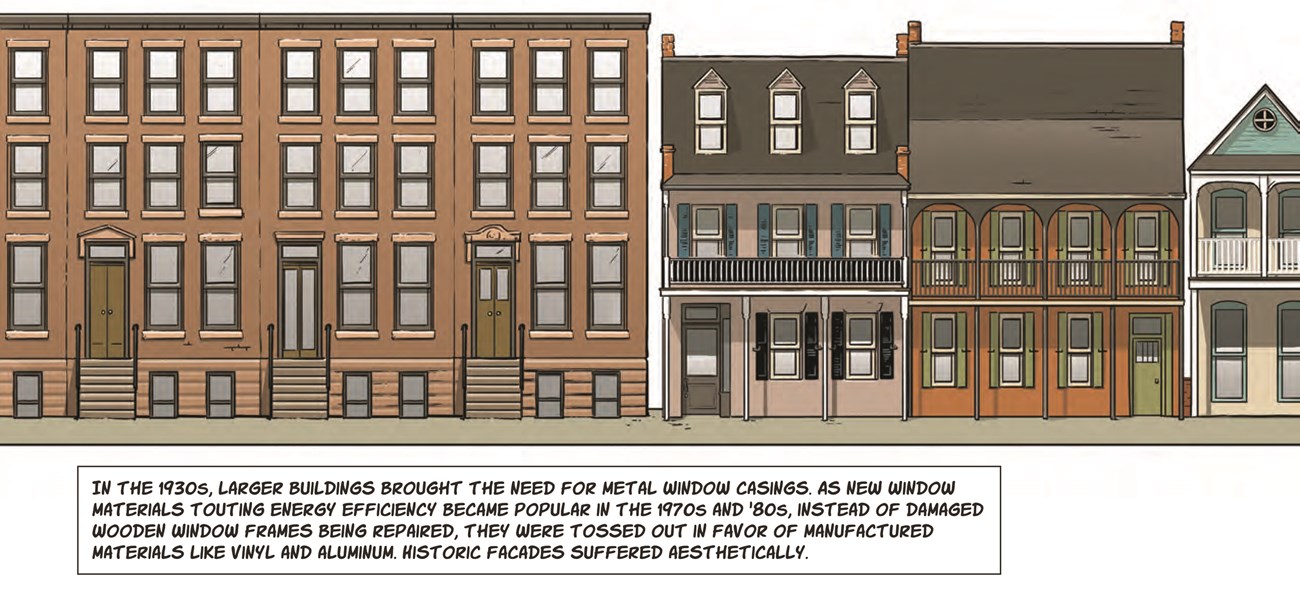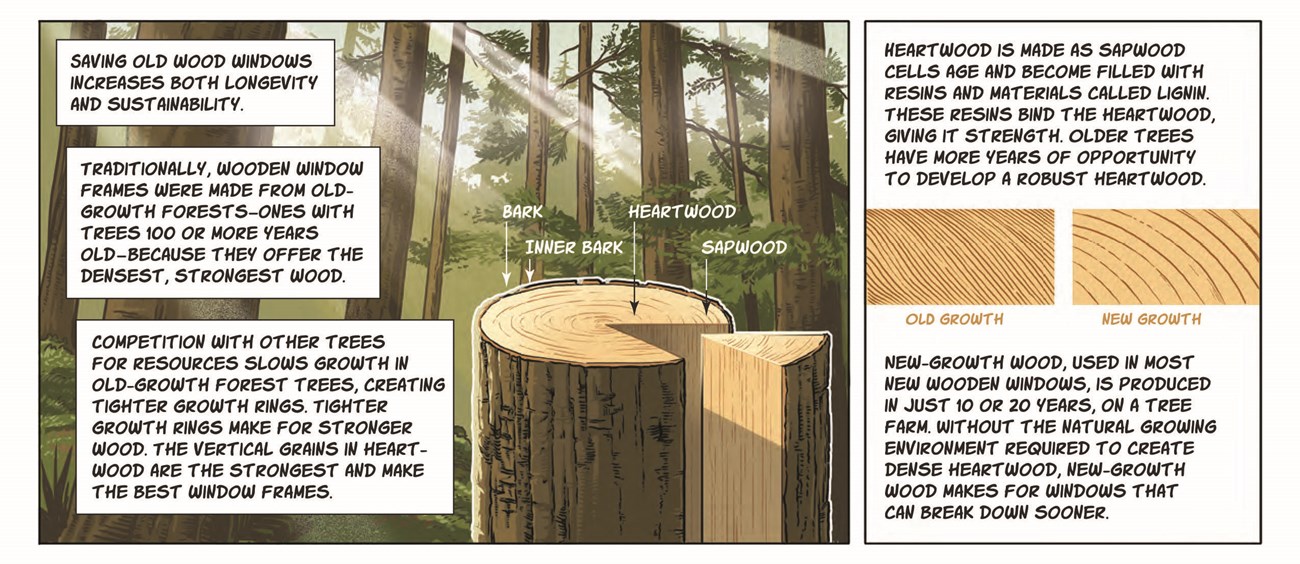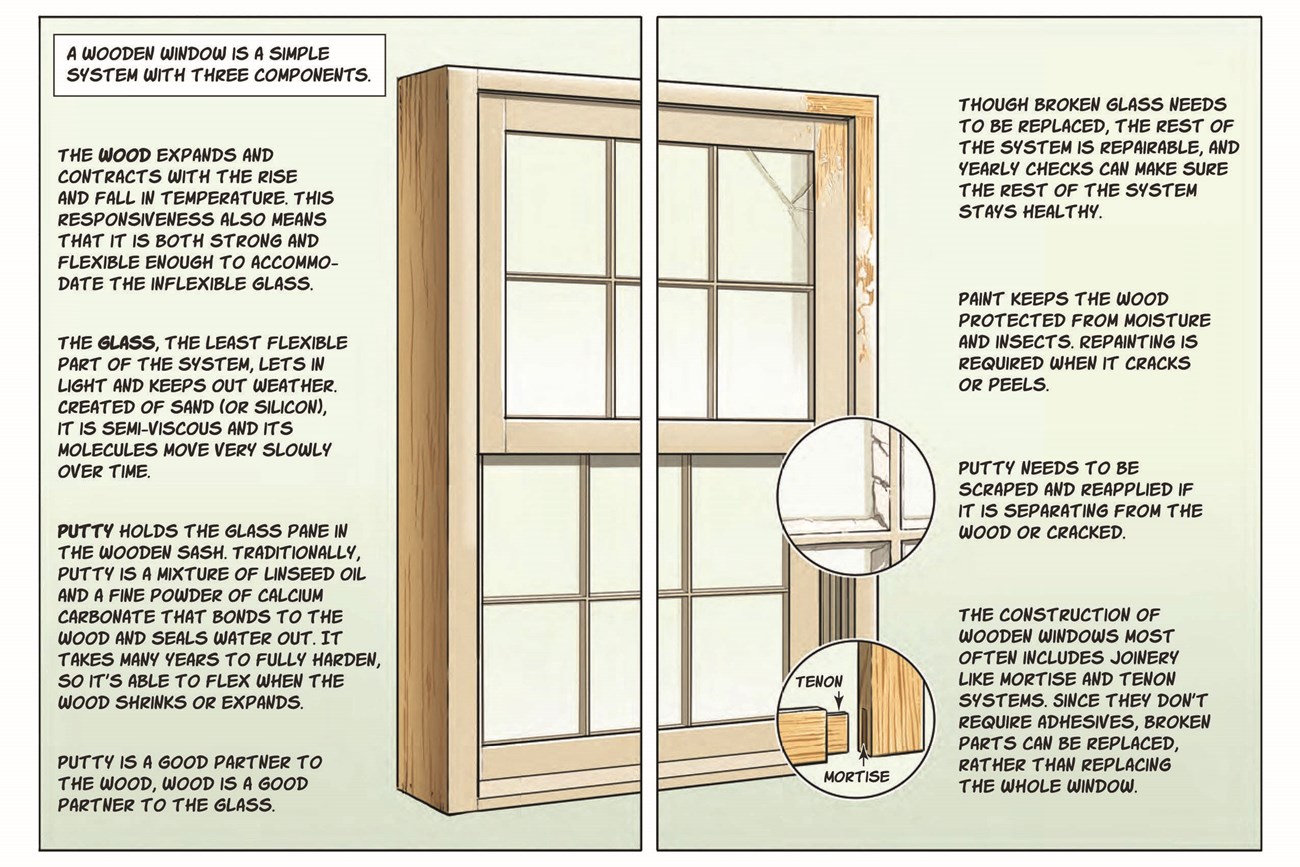Last updated: August 30, 2024
Article
Wood Windows, History’s Eyewitness
By Johnna Rizzo and Matthew Twombly

I

I

I

I

I

i

w
Transcript and Image Description
Line 1:From the first buildings built in America to the 1930s, wood windows framed people’s view of the world.
Philadelphia, 1776.
Image Description: Eight white men wearing coats, vests, and tri-corner hats, and five women standing in two groups in front of Independence Hall. The NCPTT logo and NPS Arrowhead are in the upper right corner.
Line 2: Westward Expansion, 1800s.
Image Description: A white man is chopping down a tree in the foreground. A covered wagon is on the background on the right and a partially built log cabin is in the background on the right.
Line 3: San Francisco Chinatown, Early 1900s
From Brooklyn to Bourbon Street, wood, ubiquitous and readily available, was the standard for window frames no matter the architectural style.
Image Description: On the left, nine men, women, and children wearing dark clothing walk under storefront awnings. A streetcar travels on tracks in the road on the right. Buildings with Asian inspired architectural features line the street in the background.
Line 4: In the 1930s, larger buildings brought the need for metal window casings. As new window materials touting energy efficiency became popular in the 1970s and ’80s, instead of damaged wooden window frames being repaired, they were tossed out in favor of manufactured materials like vinyl and aluminum. Historic facades suffered aesthetically.
Image Description: A street lined with four different style buildings side by side. A light brown rectangular three-story brownstone style building with three different entrances stands next to a rose-colored three-story structure with a balcony on the second floor and three dormers on the third floor. The third building is a rust-orange three-story building with green shutter on the windows and ornate trim balcony on the second floor. The final building is a narrow cream-colored two-story building with teal and white trim and balcony on the second floor.
Line 5: Saving old wood windows increases both longevity and sustainability.Traditionally, wooden window frames were made from old-growth forests – ones with trees 100 or more years old – because they offered the densest, strongest wood. Competition with other trees for resources slows growth in old-growth forest trees, creating tighter growth rings make for stronger wood. The vertical grains in heartwood are the strongest and make the best window frames.Heartwood is made as sapwood cells age and become filled with resins and materials called lignin. These resins bind the heartwood giving it strength. Older trees have more years of opportunity to develop a robust heartwood.Old Growth : New GrowthNew-growth wood, used in most new wooden windows, is produced in just 10 or 20 years, on a tree farm. Without the natural growing environment required to create dense heartwood, new-growth wood makes for windows that can break down sooner.
Image Description: On the left a tree trunk in a forest. Text and arrows point to parts of a tree. From the center outward, in the center is the heartwood and toward the outer edge is sapwood. The edge is the inner bark and outside edge is the bark.On the right are two close-ups of wood grain. On old growth the grain lines are close together and on new growth the wood grain is spaced further apart.
Line 6: A wooden window is a simple system with three components. The WOOD expand and contracts with the rise and fall in temperature. This responsiveness also means that it is both strong and flexible enough to accommodate the inflexible glass. The GLASS, the least flexible part of the system, lets in light and keeps out weather. Created of sand (or silicon), it is semi-viscous and its molecules move very slowly over time. PUTTY hold the glass pane in the wooden sash. Traditionally, putty is a mixture of linseed oil and a fine powder of calcium carbonate that bonds to the wood and seals water out. It takes many years to fully harden, so it’s able to flex when the wood shrinks or expands. Putty is a good partner to the wood.Wood is a good partner to the glass. Though broken glass needs to be replaced, the rest of the system is repairable, and yearly checks can make sure the rest of the system stays healthy. Paint keeps the wood protected from moisture and insects. Repainting is required when it cracks or peels. Putty needs to be scraped and reapplied if it is separating form the wood or cracked.The construction of wooden windows most often includes joinery like mortise and tenon systems. Since they don’t require adhesives, broken parts can be replaced, rather than replacing the whole window.
Image Description: A 12 pane double hung window divided into two parts vertically. Left side in new condition and the right is worn and weathered. The upper right pane is cracked, paint is peeling exposing wood, putty under the muntin is cracking. In the lower right corner is a magnification of the tenon and mortise joint used to construct the window frame.
Line 7: If cared for, old-growth wooden windows have a potential life span of hundreds of years, making history a vital part of today.Source: Andrea Savonty, Savonty Restoration; National Center for Preservation Technology and Training, National Park Service.
Image Description: A white woman with a dark brown hair pulled back in a ponytail wearing a long sleeve dark gray shirt is looking out a window at a brown field on the horizon.
Source: NPS DataStore Collection 9284. To search for additional information, visit the NPS DataStore.
